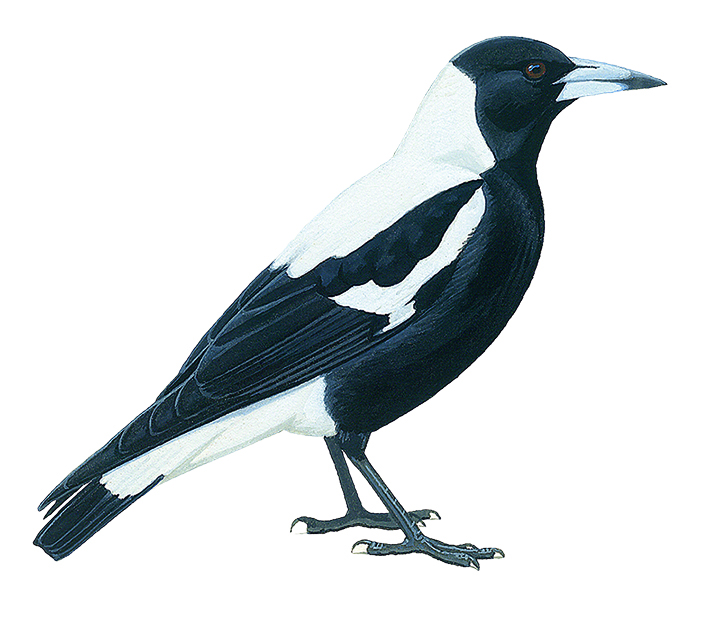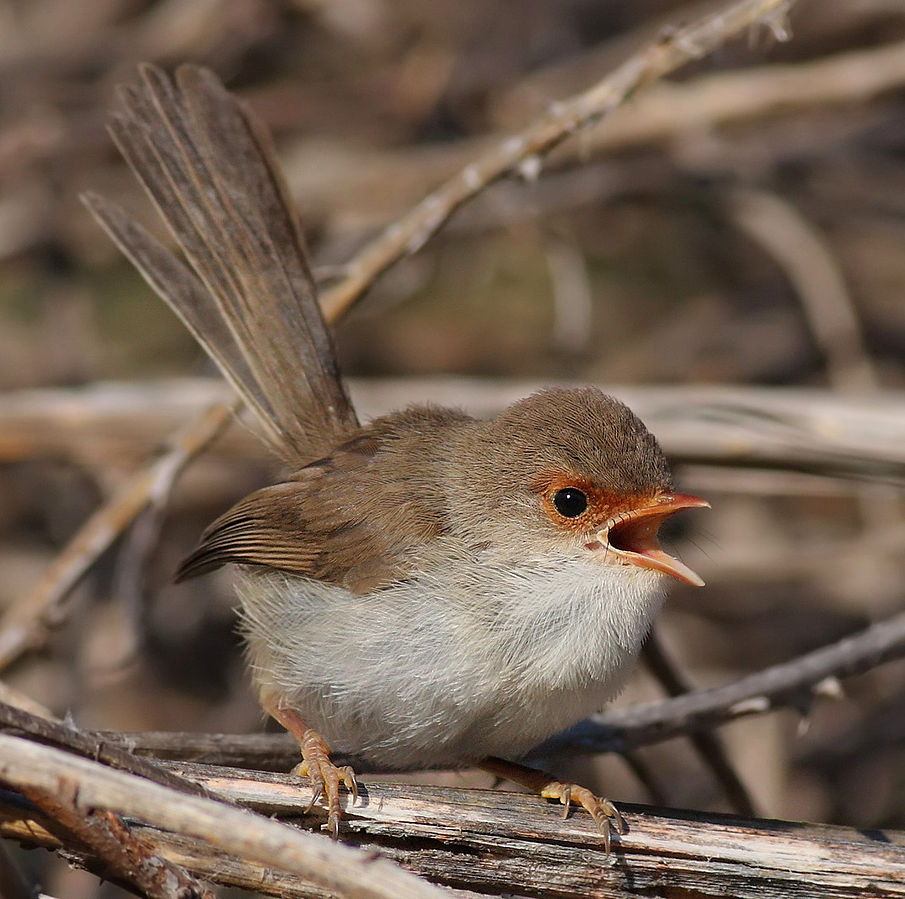Grab your binoculars and notepad, the much-anticipated Australian Bird Guide is here! To get you in the mood, read some fascinating bird facts and get some bird-watching tips from ornithologist Dr Leo Joseph.

A collage of bird drawings from the Australian Bird Guide: Wandering albatross, female and male red-tailed black cockatoo, spinifex pigeon, red-backed kingfisher and splendid fairy wren.
Just a few of the nearly 4,700 illustrations in The Australian Bird Guide. Clockwise left to right (not to scale): Wandering albatross, female and male red-tailed black cockatoo, spinifex pigeon, red-backed kingfisher and splendid fairy wren.
Bird watchers, twitchers and ornithologists rejoice: today we’ve released The Australian Bird Guide. To celebrate, we wanted to share some fascinating facts about some of Australia’s unique birds.
Warbling wonders

A drawing of The male white backed magpie
The male white backed magpie
One of the most iconic Australian birds is the magpie (Cracticus tibicen). They are the reason it’s considered completely normal for cyclists to cover their helmet in cable ties. But there’s more to these beautiful birds than you might think. They also have one of the most complex bird calls in the entire world. Their pitch varies up to four octaves and they can mimic over 35 species of native and introduced bird species. When living near people, they have even been known to mimic human speech.
Not only can the magpie mimic you, it knows you. Don’t feel too special, it knows your neighbours as well. Magpies will often stay in their ‘patch’ for their whole lives – over 20 years – and they can recognise the people within their territory, including who is nice to them.
Parasite problem
When you think of a parasite, you probably think of something really small like a worm or tick, but parasites actually come in all shapes and sizes – including birds. In fact, at up to 67 cm tall, the Channel-billed Cuckoo (Scythrops novaehollandiae) is the largest parasitic bird in the world. You heard us right – cuckoos are an actual family of birds (not just something that pops out of clocks) and the ones in our region are parasites – technically what we call brood parasites.
The channel-billed cuckoos should get an award for World’s Laziest Parents. They spend summer in northern and eastern Australia and when the female is ready to lay her eggs, she’ll make her way to a large bird’s nest (e.g. currawong, magpie, crow) and lay her eggs. The host bird will take care of the cuckoo’s egg/s along with its own and when they hatch, the host will be super proud of its amazingly big, demanding and rather odd-looking chick.

The channel-billed cuckoo spends most of it’s time in the canopy of large trees, part of the reason we don’t know a lot about them. Image: James Niland/Flickr
Unlike most cuckoos, the channel-billed cuckoo hatchling won’t bother knocking the other chicks out of the nest, rather they just demand all the food and so the poor host’s chicks starve to death. The host parent (still amazed at their ability to create such a massive chick) will continue to feed the cuckoo until it matures.
For such a large and interesting bird, the channel-billed cuckoo is secluded and we don’t know that much about them. A lot of our understanding is gained through amateur observations, so keep an eye out for them next summer!
What’s the password?
Like an evolutionary arms race, birds targeted by cuckoos are constantly evolving techniques to identify their chicks, and cuckoos have to quickly adapt to get around those techniques. For example, the superb fairy-wren (Malurus cyaneus) has developed a special technique to identify their offspring: they have a password.
While their eggs are incubating, mother fairy-wrens will sing a unique tune to them. If a horsfield’s bronze-cuckoo (Chrysococcyx basalis) comes along and lays an egg in the nest, it’s chick doesn’t have as much time to learn the surrogate mother’s vocalisation. When the parents come to feed the cuckoo chick, it may not recite the correct ‘password’ so the parents might recognise it as an imposter and abandon it.

A female superb fairy-wren singing
“What’s the password?” -superb fairy-wren mum. Image: Wikimedia Commons Fir0002, Flagstaffotos
It sounds like a fool-proof solution for the fairy-wren, but like everything in nature it’s never that simple. Cuckoos are expert adapters and in many instances their chicks have been able to mimic the host nestling’s food-begging vocalisation well enough to fool the host parents. And so the evolutionary war goes on.
Watch out!
Keen to go make the next big bird discovery but not sure where to start? We asked ornithologist (bird scientist) Dr Leo Joseph from our Australian National Wildlife Collection facility for some advice.
“It is very important to learn how to describe a bird scientifically. The new Australian Bird Guide explains how to do this in detail. Practice by describing the birds in your front yard as if they were extinct and you were re-discovering them for the first time. Be sure to use the correct anatomical terms such as crown, back, rump and upper tail covers.”
But can’t you just take a photo instead?
“Sure, a good quality image can be used for identification, but so often images aren’t high enough quality. That’s why learning how to describe birds properly is always important.”
“Recreational bird watchers make significant contributions to the scientific community’s knowledge and understanding. We’re always learning and changing things – this book is the latest but things will continue to change.”
So what are you waiting for? Grab a copy of the Australian Bird Guide from CSIRO Publishing and start watching some of the world’s most interesting animals!


7th May 2017 at 9:12 am
I was really hoping that this would be an all encompassing app. We have lots of bird books, but what I really miss is a, then, cd version, of birds in South Africa, from which you could plug in last longs, or location names, and it would generate a bird list for that area. I’ve never seen this in Australia
2nd May 2017 at 10:44 pm
a link please? :):)
3rd May 2017 at 8:10 am
Hi there,
Here’s the link to purchase the book: http://www.publish.csiro.au/book/6520
Cheers,
Ellen
2nd May 2017 at 10:39 am
I’m sure it’s a fine book but this bird guide in a format that you download to your phone would be even better. You could then include live videos of each bird and recordings of its call. A user could potentially upload a photo to find the closest match for an unknown bird. And it’s much easier to carry around in the bush.
2nd May 2017 at 7:48 pm
Totally agree. Could also ‘shazam’ a bird call to get an instant match!
4th May 2017 at 5:27 pm
Maybe someone should make an app? I have noticed that they do have ebooks but not for this edition, But of course you cannot add a bird call to an ebook anyway : (
2nd May 2017 at 8:49 am
Yeah, but isn’t that a white-backed magpie, and don’t they most likely live in St. Lucia Qld, yet only their cousins live in Toowong, a couple of ks away? Is that right?
1st May 2017 at 8:45 pm
Brilliant ??